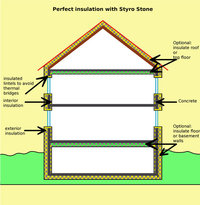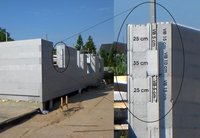1. Precondition: Well insulated house-shell
A well insulated shell is the first precondition for energy efficiency of a new building.
The shell means the foundation, the walls, windows and exterior doors and the roof. If the basement walls are not insulated, the floor above the cellar must be insulated. The same is valid for the roof. If the roof is not insulated, then the top floor must be insulated.
Styro Stones insulate the walls on both sides. The interior insulation is very important. During the winter only warm surfaces (walls and windows) guarantee a maximum of comfort. During the summer insulation prevents solar gain on the concrete.
The Styro Stone lintel stone eliminates thermal bridges and therefore the emergence of condensation, which is very often the cause of mould.
Enjoy more space by having narrow walls and maximum insulation
Styro Stones have a concrete core, making the building more solid than with all other conventional construction materials like bricks, light concrete stones etc. To achieve this stability only 150 mm of concrete are necessary. In a typical home this easily provides an additional space for a guest-toilet.
On this concrete core the insulation is set, starting with 100 mm, the Neopor-stone with 250 mm width. Usually in the UK and Ireland the Neopor-stone with 350 mm is enough, achieving a (R-value of more than 7. Using the styrostone VIB stone any level of insulation value can be catered for.
The picture shows a construction site, where for a sensational R-value exceeding 10 was provided for using a wall width of only 450 mm.
A small comparison of insulation
Remember: The higher the R-value, the better
| | | | | | Brick | 24 cm | 1,500 | 0,667 | Styro Stone | 25 cm | 0,290 | 3,44 | Styro Stone - Neopor | 25 cm | 0,260 | 3,84 | Brick with external wall insulation | 30 cm | 0,320 | 3,125 | Styro Stone - Neopor | 35 cm | 0,140 | 7.05 | Light concrete | 40 cm | 0,163 | 6,134 | Styro Stone - Neopor | 40 cm | 0,120 | 8,66 | Styro Stone - Neopor | 45 cm | 0,097 | 10,27 | Styro Stone - Neopor | 50 cm | 0,084 | 11,88 |

